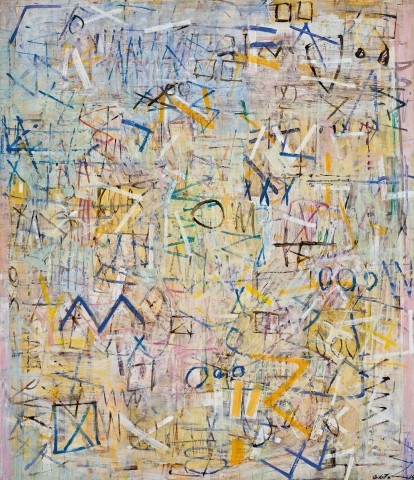WRITINGS OF OLD, 1965
YVONNE AUDETTE
oil on board
99.5 x 85.5 cm
signed and dated lower right: Audette 65
signed, dated and inscribed with title verso: 16 / Audette 1965 / writings of old / 2
Holdsworth Galleries, Sydney
Private collection, Sydney
Yvonne Audette, Holdsworth Galleries, Sydney, 10 – 28 November 1970, cat. 2
When Writings of Old was painted in 1965, Yvonne Audette had been living out of Australia for thirteen years, having moved to the United States in 1952 at the age of twenty-two. Living first in New York, where she studied at the Arts Student League of New York, she experienced the flowering of Abstract Expressionism firsthand, absorbing the diverse influence of artists such as Franz Kline, Robert Motherwell, Mark Tobey, Bradley Walker Tomlin and Willem de Kooning. In 1954, Audette made her first abstract works, which were particularly influenced by Kline’s monumental black and white gestural paintings, and after seeing one of de Kooning’s Woman series in progress when she visited the artist in his studio. Like several contemporary artists at the time, she also enrolled in Zen calligraphy classes with a Japanese master. However, while Audette has always been honest about the sources of her practice – as she has said, ‘art has got five thousand legs’1 – she was nevertheless determined, from the outset, to find her own unique voice.
After a period of travel in Spain, France and Germany in 1955, Audette settled in Florence, Italy. She later established a studio in Milan, which saw her commuting between the two cities to make work. After giving up her studio in Florence in 1963, Audette moved permanently to Milan, where she was based until her return to Australia for good in 1966.
Audette’s circle of artist friends and colleagues in Italy included Renato Birolli, Lucia Fontana, Giuseppe Santomaso and Emilio Vedova (who, Fontana aside, were all creating expressionist works of a decidedly European inflection), but it was the work of Rome-based American artist, Cy Twombly, that was to have the greatest impact on her practice at this time.2 As the title of Audette’s painting and its soft palette suggests, the artist drew as much inspiration from the history of the city around her, and the patina and marks upon its walls and tablets, as from Twombly’s characteristic scratchy signs and hieroglyphics. Yet within Writings of Old Audette transforms these sources into her own confident iconography – a masterful combination of graffiti-like scrawls and carefully considered marks, set against and amidst transparent layers that are applied, scraped back and then applied again over an extended period. Carefully constructed while seemingly ‘automatic’ in its creation, the work is a study in space and depth, and a kind of slow, mesmerising movement. As the artist has explained:
‘Transparency was always important in trying to build up the structure of the painting – every stroke and mark had a meaning. The calligraphy – that’s why I like the transparency because you could see underneath it every form, structure, mark that had been put down before – nothing was ever lost. It is like the inside of a human being, everything is there, what you say and do is always there in human experience. I want to do this in my painting; to build up layer, upon layer – put on top. Everything underneath is important.3
1. Yvonne Audette, in an interview with Bruce James, 14 November 1998, cited in Ewington, J., Yvonne Audette: Abstract Paintings 1950s & 1960s, Queensland Art Gallery, Brisbane, p. 11
2, Yvonne Audette met Cy Twombly through Italian artist Gastone Novelli in either 1958 or 1959. Yvonne Audette, artist’s notes, 1965, cited in Adams, B., ‘Yvonne Audette: The Later Years’, Heathcote, C. et al., Yvonne Audette: Paintings and Drawings 1949 – 2003, Macmillan Art Publishing, Melbourne, 2003, p. 151
3, Durie Saines, D., The Will to Paint: Three Sydney Women Artists of the 1950s, Joy Ewart, Nancy Borlase, Yvonne Audette, Masters thesis, Power Institute of Fine Art, University of Sydney, 1992, p. 100
KELLY GELLATLY
